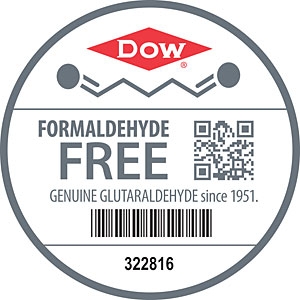Dow Microbial Control, a business group of The Dow Chemical Company, has launched a comprehensive educational campaign called “Genuine Glutaraldehyde” intended to help customers distinguish glutaraldehyde from counterfeit product options, while simultaneously promoting the numerous benefits of glutaraldehyde.
Successfully introduced more than 60 years ago, glutaraldehyde is one of Dow Microbial Control’s flagship molecules. This versatile microbiocide offers a host of advantages in applications ranging from high-level disinfection of medical equipment employed in healthcare settings to controlling microbes found in industrial operations such as oilfields and cooling towers to disinfecting poultry and swine facilities.
“During the past few years, formulators have increasingly made and sold products that are supposedly glutaraldehyde-based, but actually contain other ingredients, including formaldehyde and glyoxal,” said Mark Henning, global general manager for Dow Microbial Control. “The bottom line is that if your product does not contain genuine glutaraldehyde, you may very likely have a product with a blend of formaldehyde and/or glyoxal and possibly some small amount of glutaraldehyde. Customers could be overpaying by 50 to 200 percent, based on current average market prices for these blended materials. Moreover, there are often environmental, health and safety issues to consider with these blended products, and the personal protective equipment requirements may diffe—especially for free formaldehyde, which is a known carcinogen.”
In conjunction with its program, Dow Microbial Control has developed a variety of beneficial materials. These include a Glutaraldehyde Cost Calculator to determine how much customers should be paying for their blended products, as well as detailed technical information and fact sheets, a compendium of glutaraldehyde milestones and other helpful information.
To better educate potential customers, educators and scientists about glutaraldehyde’s proven benefits, research and development initiatives, and updates, Dow Microbial Control is utilizing Heather McGinley, Ph.D., as the focal point of a widespread educational campaign. An associate scientist with the company, McGinley has conducted extensive research about glutaraldehyde and presented a variety of technical papers at prominent industry conferences and events.
“Glutaraldehyde was first produced commercially in 1951 and offers a host of important microbial control benefits that have been confirmed through six decades of usage,” said Rick Strittmatter, global director of research and development for Dow Microbial Control. “This versatile product provides broad efficacy, is biodegradable and formaldehyde free, and is also non-carcinogenic, non-persistent and non-bio-accumulative, which distinguishes it from many other biocides.”
Although glutaraldehyde is often confused with formaldehyde and shares the chemical family name “aldehyde,” their chemical and toxicological properties differ significantly. In addition, genuine glutaraldehyde neither contains nor degrades into formaldehyde.
“Glutaraldehyde is a terrific option for many applications, and we remain committed to developing innovative and sustainable solutions that help customers manage their microbial control challenges as effectively as possible,” said Suzanne Carroll, Dow Microbial Control’s global commercial director. “We encourage customers to ask for genuine glutaraldehyde-based products from The Dow Chemical Co. or BASF—the world’s only two manufacturers of glutaraldehyde—so they know they are getting what they desire rather than blends incorporating little or no glutaraldehyde that may falsely claim to be glutaraldehyde-based. Dow Microbial Control is placing a special ‘Formaldehyde Free’ seal on many of our glutaraldehyde products to distinguish them from potential imitators and let customers know they are receiving genuine glutaraldehyde and not overpaying for an inferior product.”
Dow Microbial Control has also created a special website devoted to glutaraldehyde, which is accessible at www.Glutaraldehyde.com. It features useful glutaraldehyde-related information, including links to technical documents and resources.





Report Abusive Comment